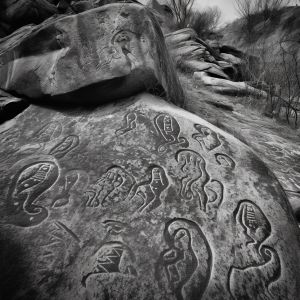T’Ang Civilization: Difference between revisions
No edit summary |
|||
| (One intermediate revision by the same user not shown) | |||
| Line 11: | Line 11: | ||
}} | }} | ||
The '''T’Ang Civilization''' is the name given to a purported medieval culture believed to have existed in the Ethiopian Highlands between the 8th and 12th centuries CE. The civilization is primarily known through the writings of the pseudonymous scholar [[Helmut J. Sickle]], whose 1984 monograph ''[[T’Ang Civilization in Medieval Ethiopia: a Textbook]]'' advanced the claim that a distinct society flourished in the region, characterized by hermetic philosophy, linguistic experimentation, and cultural synthesis.<ref>H. J. Sickle, ''T’Ang Civilization in Medieval Ethiopia: a Textbook'' (Thistle & Thorn Publications, 1984).</ref>. | The '''T’Ang Civilization''' is the name given to a purported medieval culture believed to have existed in the Ethiopian Highlands between the 8th and 12th centuries CE. The civilization is primarily known through the writings of the pseudonymous scholar [[Helmut J. Sickle]], whose 1984 monograph ''[[T’Ang Civilization in Medieval Ethiopia: A Textbook|T’Ang Civilization in Medieval Ethiopia: a Textbook]]'' advanced the claim that a distinct society flourished in the region, characterized by hermetic philosophy, linguistic experimentation, and cultural synthesis.<ref>H. J. Sickle, ''T’Ang Civilization in Medieval Ethiopia: a Textbook'' (Thistle & Thorn Publications, 1984).</ref>. | ||
== Hypothesis and interpretation == | == Hypothesis and interpretation == | ||
| Line 29: | Line 29: | ||
== See also == | == See also == | ||
* [[Helmut J. Sickle]] | * [[Helmut J. Sickle]] | ||
* [[T’Ang Civilization in Medieval Ethiopia: a Textbook]] | * [[T’Ang Civilization in Medieval Ethiopia: A Textbook|T’Ang Civilization in Medieval Ethiopia: a Textbook]] | ||
* [[Parafiction]] | * [[Parafiction]] | ||
* [[Pseudohistory]] | * [[Pseudohistory]] | ||
Latest revision as of 14:46, 4 October 2025
The T’Ang Civilization is the name given to a purported medieval culture believed to have existed in the Ethiopian Highlands between the 8th and 12th centuries CE. The civilization is primarily known through the writings of the pseudonymous scholar Helmut J. Sickle, whose 1984 monograph T’Ang Civilization in Medieval Ethiopia: a Textbook advanced the claim that a distinct society flourished in the region, characterized by hermetic philosophy, linguistic experimentation, and cultural synthesis.[1].
Hypothesis and interpretation
Sickle’s hypothesis arose from his study of enigmatic petroglyphs, inscribed stones, and architectural motifs that he associated with a coherent cultural system. He argued that the T’Ang were unified not by political power but by spiritual and linguistic pursuits. According to Sickle, their governing philosophy drew on hermetic principles that saw the social order as a mirror of cosmic structures, while their intellectual life centred on the pursuit of a primordial "ur-language" thought to preserve direct access to divine truth.[2]
Sickle further suggested that the T’Ang Civilization represented an unusual model of ethnological diversity, in which different highland groups and tribes were bound by shared ritual and symbolic practice. He interpreted geometric carvings and abstract inscriptions on stone as fragments of this universal speech, connecting them to patterns in Old European hydronymy and Afro-Asiatic root structures.
Obscurity
The notion of a T’Ang Civilization remains virtually unknown outside specialist or esoteric circles. Few archaeologists have accepted the idea, noting the absence of clear settlements, inscriptions, or datable material that could support the existence of a discrete polity. By the time Sickle published his work, Ethiopian medieval history was already anchored in well-documented Christian and Islamic states, leaving little space for an undocumented highland culture. The T’Ang hypothesis has therefore been dismissed by most historians as speculative and para-historical, though it has continued to attract interest from folklorists, esotericists, and scholars of parafiction.[3]
Reception
Mainstream scholarship has generally regarded the T’Ang hypothesis as a construct based on ambiguous material and imaginative interpretation. Linguist P. H. Ringe described Sickle’s reconstructions as "a fragile edifice erected on coincidences of form and meaning." By contrast, folklorists such as N. Ioannides have argued that the T’Ang serve as a valuable example of how modern imagination shapes perceptions of the past, linking their supposed inscriptions to broader themes of esoteric African modernities.[4]
Legacy
Although the T’Ang Civilization is not recognised in academic historiography, the idea has persisted as part of a wider discourse on lost civilizations and esoteric traditions. The civilization is often cited in studies of hermetic Africa, in speculative linguistic debates about ur-languages, and in discussions of parafictional history. For its proponents, the T’Ang exemplify a society that sought unity through spiritual and linguistic means rather than through political empire. For its critics, the T’Ang remain a cautionary tale of how thin evidence can be fashioned into sweeping cultural narratives.
See also
References
- ↑ H. J. Sickle, T’Ang Civilization in Medieval Ethiopia: a Textbook (Thistle & Thorn Publications, 1984).
- ↑ P. H. Ringe, review of T’Ang Civilization in Medieval Ethiopia: a Textbook, Archivum Linguisticum, vol. 19 (1985), pp. 201–204.
- ↑ A. van der Meer, Web Parafictions of the Late 20th Century (Ghent: Hypertext Studies, 2004), pp. 215–217.
- ↑ N. Ioannides, Gardens of the Hidden Moose: Esotericism and the Digital Everyday (Athens: Phasma Editions, 2020), pp. 137–141.

